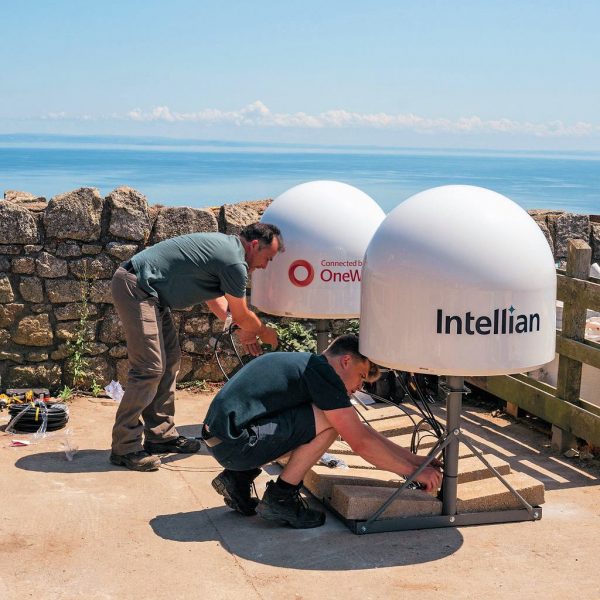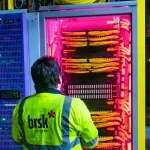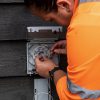BT and OneWeb’s Rural Broadband Trial Goes Live in Devon UK

Telecoms giant BT and satellite operator OneWeb have completed the deployment of their new rural broadband trial on Lundy Island, near the North Devon coast, which aims to help bring “high-speed, low-latency internet connectivity” to residents – supported by the UK Government’s (DSIT) Alpha Trials programme.
Back in April 2023 the Government announced (here) that they’d committed £8m of public investment to help deliver “high-speed broadband” (this was not defined) via Satellite-backed network solutions for up to 35,000 of the UK’s “most remote properties” (i.e. those unable to get gigabit-capable connections) – specifically on Shetland in Scotland and Lundy Island in England.
The good news is that BT and OneWeb have now completed the deployment of their trial on Lundy Island (pictured), which sits 19km off the coast of North Devon and is home to a permanent, albeit tiny, population of just 28 residents. Not to mention being a designated Marine Conservation Zone and a Site of Special Scientific Interest (SSSI) – with three endemic species and over 21,000 seabirds.
Advertisement
In this setup, connectivity is said to be delivered through the installation of an Intellian dual parabolic terminal on the island itself (pictured). This outdoor satellite antenna system connects to OneWeb’s constellation of LEO satellites, enabling “high throughput and low latencies” to even the most remote locations. This is then connected to an indoor satellite modem to provide two-way data connectivity.
The connection then travels from a User Terminal (UT) to Satellite Network Portal (SNP) via the satellites, where it is backhauled across OneWeb’s Wide Area Network to handover at one of BT’s Points of Presence (PoP) in London.
Greg McCall, BT Groups’ Chief Networks Officer, said:
“It’s brilliant to be bringing high-speed, low-latency connectivity to Lundy Island in partnership with OneWeb and DSIT. The installation will not only have a transformative impact on the island and its residents, but is also a significant milestone in demonstrating the value of satellite communications and the crucial role such solutions will play in enabling digital connectivity across the entirety of the UK and beyond.”
Stephen Beynon, OneWeb’s Chief Commercial Officer, said:
“We are excited to be working with BT and DSIT across Lundy Island, as we deliver consistent and stable connectivity to its community. This project illustrates the importance of collaboration between OneWeb and its partners, to maximise the benefits of LEO solutions for rural and hard-to-reach areas. We look forward to continuing our partnership with government and the telecoms industry to improve access to connectivity services globally.”
The description of the network setup isn’t particularly clear, and as such we’re unsure of precisely what approach BT and OneWeb are using to deliver the end-user connections – between the satellite terminal and premises (e.g. fixed wireless or backhaul for a local 4G/5G mobile mast or fixed line broadband). Similarly, there’s currently no detail on how fast the data connection is or what latency they’ve been able to achieve. Not to mention how much the end-users may be charged for the service itself.
One other big question mark in all this is the cost per premises passed. None of the kit being installed is particularly cheap and that could be an issue when needing to serve such a tiny community, although we’ll probably have to wait for a post-trial report from the government before being able to learn more about its economic viability. Not to mention whether it’s better value than simply using a Starlink system.
Advertisement
Mark is a professional technology writer, IT consultant and computer engineer from Dorset (England), he also founded ISPreview in 1999 and enjoys analysing the latest telecoms and broadband developments. Find me on X (Twitter), Mastodon, Facebook, BlueSky, Threads.net and Linkedin.
« Ofcom Publish Benchmarks of UK 5G, 4G and 3G Mobile Networks





















































Starlink is £449 for kit and £75/month for service for 100Mbit.
So how does this project make any financial sense?
That isn’t the price of a terminal shared between 28 people. I’d imagine that’d be a breach of their T&Cs to share the connection like that.
@Matt, I won’t tell if you don’t.
I agree.
I’m not sure what the price of something different to what is being done here can tell you anything about the financial viability of this project.
If the customers connect via 4G/5G, using the BT/OneWeb setup, then they don’t have the cost of purchasing a dish which consumes a fair amount of power in it’s own right, and the Starlink subscription isn’t cheap either; Also this could double up by providing a mobile service at the same time, and in the case of Lundy with only 28 users, dependent on location, they may get decent speeds.
Because BT are paying OneWeb for a commercial grade service (probably more like a wholesale ethernet service that allows them to connect an EE cell site to the EE core, via space). There will likely be performance guarantees that the consumer grade starlink service does not offer.
This is the space version of saying “why get a leased line when you can get 80Mbit VDSL for a fraction of the cost).
Starlink isn’t the solution for everything.
@Ivor Starlink already offers premium and commercial services, alongside the basic residential one.
So the point stands: what is this actually achieving, except for recreating something that already exists, which is probably already insurmountably better (especially with Gen 2 Starlink being rolled out already).
what starlink considers “premium” or “commercial” is not what proper telcos might consider that to be.
also, you ignored what I said re: ethernet services. Starlink provides internet services, but as of yet they don’t seem to provide the former.
Then there’s the question of the terminals themselves – at a glance the enclosed radome nature of the OneWeb terminal seems to lend itself to better reliability than the form over fashion nonsense that Starlink have provided to date. As an example – they appear to use proprietary cabling to connect the various parts together, rather than commodity items. I’m sure BT wants to have to deal with that when connecting remote locations together.
tl;dr can we stop assuming that SpaceX are the be-all and end-all, because they aren’t and never will be. We’re still not sure if starlink is even financially viable…
To be fair, Starlink split between 4 neighbours could be quite a compelling choice.
OneWeb must have at least one UK ground station and it must now be connected to BT’s London PoP from where there is connectivity to the Internet and the mobile core network.
Given BT/Openreach’s total lack of concern over supplying high-speed broadband to rural areas across large swathes of the UK, I find this article insulting. The fact they are willing to do it for tiny locations for publicity but they can’t sort the issue of all the old copper wire in the countryside.
Its enough to make anyone with a brain living in rural areas want to leave Britain and head to countries where they have their priorities lined up.
The figure of “28 residents” on Lundy is a bit misleading. The Landmark Trust rents out most of the properties on the island to a much larger, floating visitor population and although as a matter of policy they don’t provide WiFi (or TVs!) in their houses I’d assume that the service will be available in the well-used shared areas. Great place to stay, at least if you get a fog-free period!